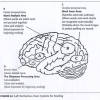Posts Tagged ‘
sound ’
Jan 11th, 2013 |
By dkrupke
The Challenge of the Squiggly Lines Providing staff development offers many opportunities to interact with educators. Some are willing to share their thinking during the training sessions via questions and statements that call for “clarification”. Some thoughts and/or questions reflect a sense of doubt or skepticism, while some are just searching for confirmation of their thoughts & ideas. One of the concerns that is expressed during Visual Phonics trainings involves the thought that adding written symbols under print will confuse students, more so for those who struggle with the “code” of English and are already confused by the variability of the sounds that letters represent. This concern is logical from the perspective of educators whose concept of early literacy skills is founded in letter knowledge, with letter-sound knowledge in a secondary position of importance. I have given this question a great deal of thought through the years. The fear of confusing students with additional characters in the print field would appear to be valid if students viewed both letters and Visual Phonics written symbols as the same kind of “squiggly lines” on the page. At first glance, both are squiggly lines that represent something and that is where the similarity […]
Posted in Visual Phonics |
1 Comment »
Tags: coding, consistent, mapping, preservice teachers, reading, sound, spelling patterns, symbols, transparency, Visual Phonics, written symbols
Apr 3rd, 2012 |
By dkrupke
By Dave Krupke During four decades of service as a public-school speech-language pathologist in the mid-west, I have been in many preschool program settings – both regular education and special education. I have seen many focused attempts to teach letter names to 3, 4 and 5 year old children, ranging from making letters in sand tables, in shaving cream, with Elmer’s glue, with chalk, with large crayons, with markers, and by tracing a letter made from sandpaper. There were many teacher attempts to associate these letters with student names in the class and with common objects, but it dawned on me just a few years ago that there was one thing missing – there was little or no purposeful attempt to associate the letter sound with the letter name! As a result, I began asking teachers about why they did not specifically facilitate letter-sound knowledge and the typical response was that they thought that letter names needed to be taught first and the children would learn the sounds later. It struck me that this was a stark example of an unintentional instructional mismatch – the adult concept that letter names should be taught first in a systematic, linear way in […]
Posted in Thoughts |
No Comments »
Tags: alphabet, learning, letter names, mapping, sound
Nov 26th, 2010 |
By dkrupke

As more educators come to understand learning and the brain, teaching practices and strategies improve, benefiting all learners. The following is a brief summary of information from the work of Dr. Sally Shaywitz and Dr. J. Richard Gentry relative to brain systems for reading. Broca’s area (area A in Gentry’s diagram of the brain) is the Phoneme Processing Area. This is where subvocalization occurs . . a process that is slow and analytical and most likely to be used in the beginning stages of learning to read, according to Shaywitz and Gentry. This area might be activated when a K teacher has children shouting out the rhyming word in a nursery rhyme as they repeat a part in unison. Broca’s area is also the “speech” area, dealing with articulation . . . how sounds are formed in the mouth. The second area of importance is the Word Analysis Area in the parieto-temporal area of the brain (area B). This is where words are pulled apart and put back together, in essence, linking sounds to letters. It is my belief that the use of Visual Phonics hand shapes helps to activate this area. This is also slow and analytical . . […]
Posted in Brain |
No Comments »
Tags: Brain, chunk, learning, mapping, reading, sound, spelling patterns, visual images, writing
Sep 20th, 2010 |
By dkrupke
Editor’s Note: The author teaches reading courses at the University of Dubuque in Iowa. After becoming an enthusiastic supporter of See the Sound/Visual Phonics, she was asked to relate her experiences with her college students and their reactions to STS/VP. The following is her response, which includes a review of current research and a rationale for all teachers to include STS/VP in their reading programs. Background I love my job! For over 25 years I have either helped children learn to read, or taught aspiring teachers how to help children learn to read. As many teachers tend to do, we teach what we were taught. For example, I learned to read primarily by using phonics. My teacher stressed phonics as a useful strategy for figuring out new words, and it worked well for me. At least, I don’t remember struggling with the reading process. Therefore, I teach phonics in my college courses for the elementary reading endorsement. Even though phonics instruction was controversial for many years, I continued to think it was important and included it in my reading courses, rebel that I am. I begin each semester by asking my students, “How many of you were taught phonics as […]
Posted in Visual Phonics |
7 comments
Tags: beginning readers, brain-compatible, DIBELS, differentiated learning, hand shapes, learning, learning style, letters, Movement, multiple intelligences, multisensory, neuroscience, phonemic awareness, phonics, preservice teachers, reading, research, sound, strategy, Visual Phonics
